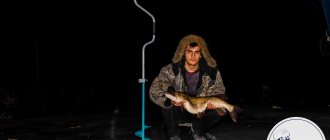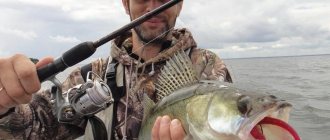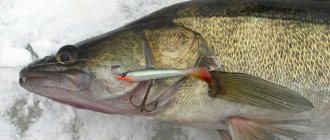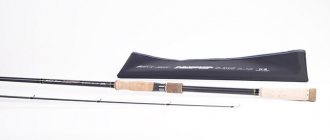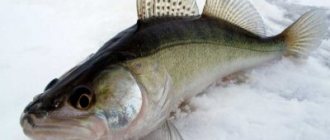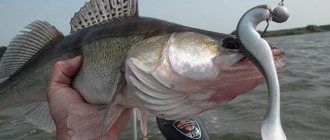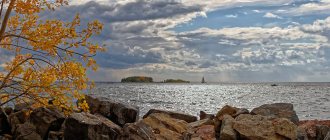We continue the series of publications about methods of catching fanged predators. Today we will tell you how to catch pike perch at night and what to use. We will also dwell on the features of night fishing in open water at different times of the year. We hope that some advice from professionals on how to catch pike perch at night will definitely be useful to you. Traditionally, at the end of the article, we will summarize and draw conclusions.
Promising places
Coming to the shoreline at night, pike perch often choose areas near flooded trees, not far from deep places.
Most of the time the fanged one is in the bottom layer. Here it can be found on dumps, sharp coastal edges and other bottom anomalies. In rivers, pike perch also chooses areas with uneven bottoms or snags. These are convenient places for an ambush. Coming to the shoreline at night, pike perch often choose areas near flooded trees, not far from deep places. The following are considered promising places for night fishing for pike perch:
- Shoals and spits with sand and gravel at the bottom.
- Riffles with depths of 3-4 meters.
- Places below dams and dams.
- Areas of water with reverse flow.
- On the border of sandy and rocky spits.
Note! You should not look for pike perch at night in areas where the bottom is covered with silt. Most often there is a zero result here.
We did not specify specifically in what places the predator stands at different times of the year. We just summarized the prospect of catching a fanged one, since many factors influence the location of the fish.
Fishing tactics and tips
You cannot provide all possible fishing options and fishing spots, but there are recommendations that should always be followed:
- until it is determined where the fish are biting, the donks must be cast at different distances from the shore;
- Donks thrown at different distances will allow you to control schools of pike perch from the moment they leave the depths until the moment they return to the pits;
- the determining factor for success during night fishing with jigs and retractable leash is complete control over the retrieve;
- for night fishing it is necessary to prepare a place during the day - most baits break off on the shore at night;
- A fisherman’s equipment at night must necessarily include several lighting sources, mosquito repellents, warm clothing, light and sound alarms for donks;
- To achieve success in hunting pike perch using a spinning rod, it is advisable to practice blind fishing during the day, i.e. check the gear for sensitivity without vision;
- night pike perch often bite more confidently and sharply than daytime pike perch, so the angler should always be prepared for a sharp and clear hook;
- Every change in the game of the bait should end with a hook;
- When fishing for a “passive” pike-perch, you must not relax until the moment when the fish is in your hands or in the padnet – the fanged one is capable of starting a fight right next to the shore.
An indisputable fact is the success of catching pike perch at night. But you don’t need to think that the pike perch itself will cling to the hook. To ensure success, careful study of fishing areas and preparation of gear is necessary.
Bait selection
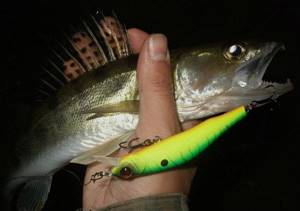
Often fishermen, especially beginners, do not know what bait to offer pike perch. We recommend using wobblers at night:
- In a combination of light and yellow colors.
- Plain white coloring.
- Scarlet or red colors and their shades are also suitable at this time.
- The bright green saturated color performed well.
We recommend reading: Winter fishing for bream on the devil
The trick of night spinning fishing, a hit so to speak, is the use of luminous wobblers. In this case, it is advisable to arm yourself with a headlamp to recharge the bait. The paint of plastic baits contains phosphorus, which, as is known, is capable of accumulating light for some time.
Foam rubber baits also do not give up their leading positions, especially if you use the wiring technique - dragging. Foam fish of bright colors are mounted on solid jig heads with an open hook or on an offset rig with a Cheburashka sinker. This kind of fishing has much in common with regular jig fishing for pike perch, but at night you should do more aggressive fishing. By knocking on the bottom, the sinker makes a sound that is clearly audible to the predator, which allows the bait to become noticed faster.
What to look for when choosing?
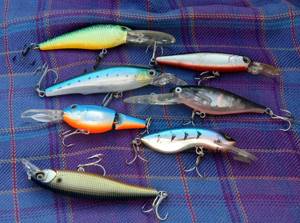
- Size. When choosing the size of the bait, you should focus on the size of the expected prey: fish up to one kilogram can be caught with a 3 cm bait, if the expected weight of the prey is 4 - 8 kg, it is advisable to use an artificial fish 5 - 10 cm.
- Color. Among the catchable colors of the bait are orange, black and red. In winter, wobblers of pink, orange and silver colors give good results.
- A game. This criterion is considered especially important in choosing a working bait; the reaction of the predator will depend on its characteristics, whether it will react or not. Here it is recommended to give preference to products with an average speed of play and a believable appearance.
- The presence of noise and sound effects is mandatory.
- Form. There can be many design options, but using a teardrop-shaped and slightly flattened configuration gives a greater effect.
It is necessary to use one or another type of bait in full accordance with the specific fishing conditions:
- In fast-flowing reservoirs where there is no dense vegetation, models with a depth of 2 m are suitable.
- During the period of schooling , when pike perch hunts for fry, baits that imitate small fish work well. But at the same time, the game must be fast in order to attract the attention of the predator as much as possible.
- In reservoirs with a quiet current, products without unnecessary loading are used, immersed to a depth of 1.5 m.
- The sinking version of the wobbler is recommended for catching prey from a depth of three meters; they are lowered slowly at an angle of 20 degrees.
- The bright colors of the products are especially relevant for night hunting, while the working depth should be over 2 m.
- During the fight, wiring should be done close to the water surface, but no more than 0.5 m. To enhance the effect of a wounded fish, the bait is then raised and lowered.
- Winter fishing involves the use of special products with a unique game and light weight. Such models are characterized by smooth immersion and are devoid of sharp fluctuations that negatively affect the bite.
- The bright colors and fast action of the bait are ideal for fishing in the warmer months of the year.
Gear requirements
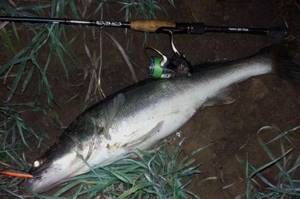
The probability of breaking through the bony mouth of a pike perch with a powerful rod is more likely. Very often, catching pike perch at night is more effective than during the day. The fanged predator, by itself, prefers to feed in the dark. Many fishermen associate this with its emergence into shallow water that has cooled down a bit. But this theory only applies to hot weather.
Clearly expressed (no hourly activity), unlike, for example, catfish. But a certain pattern is visible. It is necessary not only to choose the right equipment, but also to prepare the gear.
Rod
Catching pike perch at night using a spinning rod involves using a medium-sized stick. When fishing from a boat, a form 2.2-2.7 meters long is suitable. For fishing from the shore, you can use a 2.4-2.7 meter rod. At night there is no need for long casts.
Consequently, the number of idle bites and annoying mishaps when hooking will be reduced. At night it is better to use a spinning rod with 40 grams of dough. These are the optimal indicators. Such a stick can accept and successfully resist a large predator.
Coil
There are no specific requirements for this attribute. A classic spinning reel is often used. Its dimensions: 2-3 thousand. The multiplier works well if fishing takes place in the current, using large loads.
We recommend reading: Features of trout fishing with a spinning rod
Features of night fishing at different times of the year
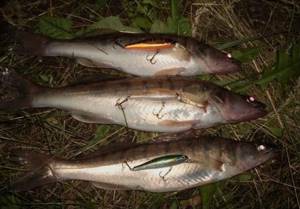
Catching fangs in the dark is possible throughout the open water season.
in spring
Silicone baits work well, mainly twisters and vibrotails. The color scheme is classic. Often, brilliant predators are seduced by shiny baits. At this time, the predator hunts before the spawning run. There is no need to rush to pack your gear at dawn.
It is possible that just at dawn, you can feel a blow to your hand and pull out a trophy specimen.
In summer
Active play is successful, with a slight amplitude. About sizes: length from 70 to 120 millimeters. To deliver at the optimal distance, 7 grams is enough. In summer, predators plow the shallow waters of rivers, in areas of shallows and sandbars. They stand on rifts where the bottom is covered with pebbles, stones or sand.
Do not pass by shallow areas in the area of stone embankments that reinforce the banks.
On a note! Bridge supports in the area of the piers serve as an ambush for the fanged one. In summer you can actively catch predators from the coastline.
in autumn
In the fall, anglers often focus on trolling and fishing from a boat during the day. However, it is trophy pike perch that is most often caught at night in the fall.
In September, the predator switches to the autumn feeding regime, ignoring or rarely visiting the shallows. An appetite can come to an inhabitant of the underwater world immediately after sunset. On warm autumn days, night fishing for pike perch using wobblers can be the most productive. At the end of autumn, the bite on artificial summer baits fades away. With the arrival of November, it is better to catch pike perch using live bait or plumb from a boat.
Often the predator's meal occurs well after midnight. It is important to know the characteristics of the reservoir and find out from the “aboriginals” the habits of the fanged fish in the autumn. Without these components, the catch can be reduced to zero.
We recommend reading: Black Sea scorpionfish ruffe
Catching pike perch at night in autumn
With the onset of autumn, the fanged fish takes bait more and more actively during daylight hours. This period is considered the best for spinning fishermen, who go en masse to bodies of water in search of predators. However, experienced fishing masters know that pike perch continues to catch well at night. The main thing is to find promising points and choose the fishing strategy wisely.
In the autumn, night fishing brings many trophy specimens, which during daylight hours are reluctant to respond to the offered bait. Typical places where encounters with hefty individuals are most likely are:
- channel rifts with medium depths and sharp changes;
- single snags or logs, flooded in the middle of the river bed;
- stone ridges at the borders with channel edges and dumps;
- bridge supports;
- long ditches with sharp slopes.
There is no need to look for the fanged one in the usual holes or snags with great depth. Here, the bulk of the pike perch have eaten during the day and can simply rest. The remaining hungry individuals went to the middle depths and the nearest edges, where there is more available food and it is easier to hunt.
Of the lures, you should give preference to classic jigs. Regular twisters, worms, vibrating tails, foam rubber or polyurethane foam fish are suitable. On a clean bottom, you can try using front-loaded spinners.
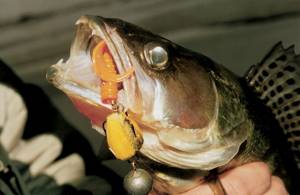
Photo 3. Autumn pike perch on a composite jig bait.
When fishing for riffles from a boat, diving crankbait wobblers are a good choice. They are able to quickly reach the bottom and effectively seduce the fanged one. It is important to choose a model that will periodically scratch the ground. Raising turbidity and additional noise will attract the attention of the pike perch, and it will react much more actively to the bait.
Advice from professionals
Going out to a body of water at night requires the use of a certain set of equipment. The first thing is not to forget the lighting fixtures. Bring flashlights, compact lamps and a headlamp. Will need to be supplied with spare batteries. Bite alarms when fishing for pike perch at night from the shore will help you respond quickly in any situation.
Even when it’s warm, you need to take warm clothes when fishing. At night, the air temperature, especially near the water, drops significantly. A baseball cap or cap would be a useful accessory.
Insects will stay away from you if you use repellents for protection.
Important . Avoid even the slightest contact of mosquito repellents on the bait. Pike perch has a keen sense of smell; foreign odors will alert it.
Even if it’s still warm in autumn, it’s better to add gloves and a hat to the list of necessary things. Keep your feet warm by wearing waterproof, insulated shoes or foam rubber boots with thick neoprene inserts.
Having signals on your boat is essential for the safety of you and your colleagues at night. An echo sounder will speed up the search for a predator. You can find out the bottom topography and record operating points using an echo sounder and a GPS navigator.
Intermediate conclusion: in the spring, night fishing does not give the opportunity to open up to the fullest extent than at dawn. In the summer you can catch a good number of “tails” and practice. In the fall, there is a high probability of catching test specimens and trophy specimens.
Peculiarities of pike perch behavior
Pike perch is considered a nocturnal schooling predator. After sunset, this fish becomes active, moves around the water area and hunts for small, narrow-bodied fish. The fanged one is most active at dawn, as well as around midnight. During other hours, the fish experience a slight decrease in appetite.
Pike perch begins to fish for spinning at night in the spring, when it begins its pre-spawning run. During this period, many fishermen, not waiting for the fanged fish to emerge at dawn, pack up and leave the reservoir. Experienced spinning anglers stay on the shore for an hour. Often this bears fruit in the form of several confident bites and weighty fish.
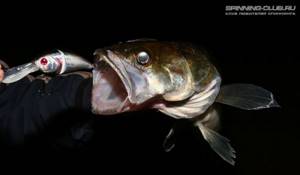
At the end of spring after spawning, the fanged fish gradually switches to a summer feeding regime. During the day, the predator is active with short-term exits. Pike perch are most active at night. It reaches various shallow sections of rivers, where whitebait accumulate in abundance.
In autumn, pike perch continues to be caught at night. Few fishermen know about this and are content with only daylight hours. However, in the dark, it is the trophy specimens that are caught that are reluctant to take bait during the day.
In ice-free sections of rivers, fishing for pike perch at night in winter is practiced, and quite successfully. There are still few fans of winter spinning rods, since fishing is difficult, not everyone can withstand the cold and other “delights” of winter. But there are no barriers for fans of paddle boarders; they go to the river at any time of the year. Detailed article: How to catch pike perch in winter read here.
